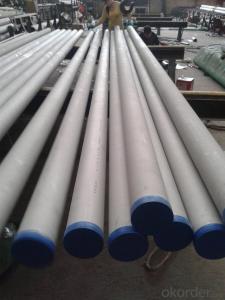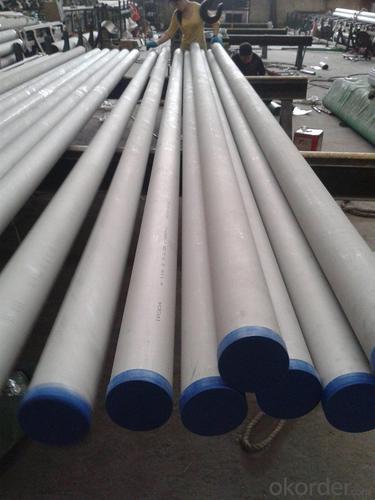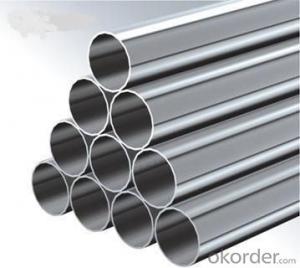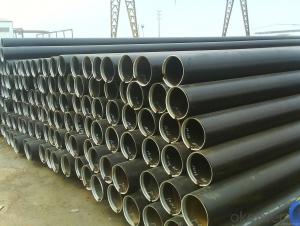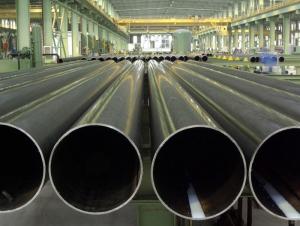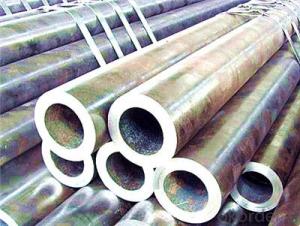Stainless steel tube; high quality
- Loading Port:
- Guangzhou
- Payment Terms:
- TT OR LC
- Min Order Qty:
- 50 m.t.
- Supply Capability:
- 10000 m.t./month
OKorder Service Pledge
OKorder Financial Service
You Might Also Like
Quick Details
| Standard: | JIS,AISI,ASTM,GB,DIN,CE | Place of Origin: | Guangdong China (Mainland) | Brand Name: | QX |
| Model Number: | 201/202/304/316/316L/430 | Type: | Welded | Steel Grade: | 300 Series |
| Application: | Decoration,construction, upholstery | Certification: | ISO | Welding Line Type: | ERW |
| Thickness: | 0.3mm to 3.0mm | Outer Diameter: | 9.53mm to 159mm | Polish: | Satin,Bright or Mirror |
| Grade: | 201,202,301,304,316,316l,430 ect. | Length: | In gernal 5.8m/6m or as customer request | Process method: | Hot rolled |
| Test: | Squash test, water pressure test,extended test,crystal rot test etc. | Production Standard: | ASTM A554 | Materials: | SUS 304, 201, 316, 316L,430 ect |
| OD tolerance: | + / - 0.15mm | Thickness tolerance: | +/- 10% | Length tolerance: | +/- 10mm |
Packaging & Delivery
| Packaging Detail: | Every tube is sleeved in plastic bag individually, and then several tubes are packed by weaving bag, which is seaworthy. Or 50kg/bundle, 500kg/bundle.We can pack as clients' requirement. |
| Delivery Detail: | 25 - 35 days for a full container. |
Specifications
Stainless Steel Pipe:
1.201,202,301,304,316L,430,etc
2.OD:6mm-159mm
3.Thickness:0.25mm-3.5mm
4.Finish:Mirror,Satin,Hairline
- Q: How do you calculate the deflection of stainless steel pipes under load?
- The deflection of stainless steel pipes under load can be calculated using various formulas and equations based on the specific properties of the pipe, such as its diameter, thickness, and Young's modulus. One commonly used formula is the Euler-Bernoulli beam theory, which considers the pipe as a simple supported beam. Other methods, such as finite element analysis, can also be employed for more accurate calculations.
- Q: Can stainless steel pipes be used for seawater applications?
- Yes, stainless steel pipes can be used for seawater applications. Stainless steel is highly resistant to corrosion and can withstand the harsh conditions of seawater, making it an ideal material for pipes used in marine environments. The chromium content in stainless steel forms a protective oxide layer on the surface of the pipes, preventing corrosion and ensuring durability. Additionally, stainless steel pipes have good strength and can handle high-pressure situations, making them suitable for various seawater applications such as desalination plants, offshore oil rigs, and shipbuilding.
- Q: What is the difference between stainless steel pipes and PVC pipes?
- Stainless steel pipes are made from a durable and corrosion-resistant material, while PVC pipes are made from a lightweight and cost-effective plastic. Stainless steel pipes are suitable for high-pressure and high-temperature applications, while PVC pipes are commonly used for water supply and drainage systems. Additionally, stainless steel pipes have a longer lifespan and can withstand harsh environmental conditions, whereas PVC pipes may degrade over time and are more prone to cracking or breaking.
- Q: Can stainless steel pipes be used in nuclear power plants?
- Indeed, stainless steel pipes are viable for utilization in nuclear power plants. Due to its exceptional robustness, resistance to corrosion, and capability to endure extreme temperatures, stainless steel is frequently employed in the construction of nuclear power plants. Specifically, stainless steel pipes are well-suited for the transportation of coolants, gases, and other fluids within the power plant. These pipes are adept at managing the rigorous demands and prerequisites inherent in a nuclear power plant, including the elevated pressures and temperatures encountered in certain sections of the facility. Moreover, stainless steel exhibits resistance against radiation-induced corrosion, rendering it a dependable option for implementation in nuclear power plants.
- Q: Are stainless steel pipes suitable for pulp and paper mills?
- Yes, stainless steel pipes are suitable for pulp and paper mills. They offer excellent corrosion resistance, durability, and high temperature resistance, making them ideal for handling various chemicals and fluids used in the pulp and paper industry. Additionally, stainless steel pipes are easy to clean, reducing the risk of contamination and maintaining high hygienic standards required in these mills.
- Q: What is the pressure rating of stainless steel pipes?
- The pressure rating of stainless steel pipes may vary based on various factors, including the grade of stainless steel, pipe wall thickness, and pipe diameter. Typically, stainless steel pipes have high pressure ratings due to the material's strength and corrosion resistance. However, consulting the relevant standards and specifications is necessary to determine the precise pressure rating for a specific stainless steel pipe. These standards (such as ASME B31.3 or ASTM A312) offer guidelines and calculations to establish the maximum allowable working pressure (MAWP) based on the mentioned factors. To ensure safety and prevent any potential failures or leaks, it is crucial to verify that the pressure rating of the stainless steel pipes is suitable for the intended application.
- Q: What are the limitations of using stainless steel pipes?
- There are several limitations associated with the use of stainless steel pipes. Firstly, stainless steel pipes tend to be more expensive compared to other materials such as PVC or copper. This can make them less feasible for projects with budget constraints. Secondly, stainless steel pipes can be more difficult to install and require specialized tools and equipment. This can increase the overall installation time and cost. Another limitation is that stainless steel pipes are not suitable for transporting certain corrosive chemicals or gases. They may react with certain substances, leading to corrosion and potential damage to the pipes. In such cases, alternative materials like plastic or lined pipes may be more appropriate. Additionally, stainless steel pipes may have limitations in terms of temperature and pressure resistance. While they can handle relatively high temperatures and pressures, extreme conditions may require the use of more robust materials. Furthermore, stainless steel pipes have a lower thermal conductivity compared to other materials, meaning they are not as efficient at transferring heat. This can be a limitation in certain heating or cooling applications where rapid heat transfer is required. Lastly, stainless steel pipes can be prone to expansion and contraction with temperature changes. This may require the use of expansion joints or other measures to accommodate for these movements and prevent potential damage. Overall, while stainless steel pipes offer numerous benefits such as durability and corrosion resistance, their limitations should be carefully considered before selecting them for a particular project.
- Q: Do stainless steel pipes require insulation?
- Stainless steel pipes generally do not require insulation, as they have a high resistance to corrosion and can withstand high temperatures. However, there are certain situations where insulation may be necessary. For instance, when transporting fluids at extremely low temperatures, insulation helps to prevent heat transfer and maintain the temperature of the fluid. Additionally, in environments where condensation may occur, insulation can prevent moisture from forming on the pipes and causing potential damage. Overall, the need for insulation in stainless steel pipes depends on the specific application and the conditions in which they are used.
- Q: How do you cut stainless steel pipes?
- Cutting stainless steel pipes can be done using several methods. Here are a few common techniques: 1. Using a hacksaw: This is a manual method of cutting stainless steel pipes. Make sure to choose a blade specifically designed for cutting metal. Secure the pipe in a vise or clamp to prevent it from moving while cutting. Mark a straight line where you want to cut and slowly and steadily saw through the pipe using back and forth motions. Apply consistent pressure to avoid damaging the pipe. 2. Using a reciprocating saw: A reciprocating saw with a metal cutting blade can also be used to cut stainless steel pipes. Clamp the pipe securely and mark the cutting line. Start the saw and slowly guide it along the marked line, applying steady pressure. This method is quicker than using a hacksaw and requires less manual effort. 3. Using a pipe cutter: A pipe cutter is a specialized tool designed to cut pipes cleanly and accurately. It consists of a sharp cutting wheel that is rotated around the pipe, gradually tightening it until the pipe is cut. This method is efficient and provides a smooth, burr-free cut. However, it may not be suitable for thicker or larger diameter stainless steel pipes. 4. Using a plasma cutter or a grinder: For thicker or larger diameter stainless steel pipes, a plasma cutter or a grinder equipped with a cutting wheel can be used. These power tools are capable of cutting through stainless steel quickly and efficiently. However, they require more expertise and safety precautions, so it is recommended to seek professional assistance if you are not familiar with these tools. Remember to wear appropriate safety gear, such as gloves and eye protection, when cutting stainless steel pipes. Additionally, always double-check the accuracy of your measurements and take necessary precautions to avoid injury.
- Q: What is the difference between 304J9 and 316J9 stainless steel pipes?
- The composition and properties of 304J9 and 316J9 stainless steel pipes differ significantly. 304J9 stainless steel pipes are categorized as part of the 304 series, which is a widely utilized austenitic stainless steel grade. This grade is composed of 18% chromium and 8% nickel, resulting in commendable corrosion resistance and excellent formability. It finds extensive applications across various industries, such as construction, food processing, and pharmaceuticals. On the contrary, 316J9 stainless steel pipes belong to the 316 series, an upgraded version of the 304 series. The composition of the 316 series includes 16-18% chromium, 10-14% nickel, and 2-3% molybdenum. The addition of molybdenum notably enhances its corrosion resistance, particularly in environments containing chlorides or other corrosive agents. Consequently, 316J9 stainless steel pipes are commonly employed in marine applications, chemical processing, and coastal settings. Regarding mechanical properties, 316J9 stainless steel pipes generally exhibit superior tensile strength and yield strength when compared to 304J9 stainless steel pipes. This increased strength is primarily attributed to the inclusion of molybdenum, which improves the alloy's capacity to endure stress and deformation. Moreover, the presence of molybdenum in 316J9 stainless steel pipes also enhances their resistance against pitting and crevice corrosion, making them more suitable for aggressive environments. However, it is essential to note that 316J9 stainless steel pipes may prove more costly than 304J9 stainless steel pipes due to the higher alloy content. Ultimately, the selection between 304J9 and 316J9 stainless steel pipes is contingent upon the specific application and the desired level of corrosion resistance. While 304J9 stainless steel pipes offer satisfactory general corrosion resistance, 316J9 stainless steel pipes present superior resistance in harsher environments.
Send your message to us
Stainless steel tube; high quality
- Loading Port:
- Guangzhou
- Payment Terms:
- TT OR LC
- Min Order Qty:
- 50 m.t.
- Supply Capability:
- 10000 m.t./month
OKorder Service Pledge
OKorder Financial Service
Similar products
Hot products
Hot Searches
Related keywords
